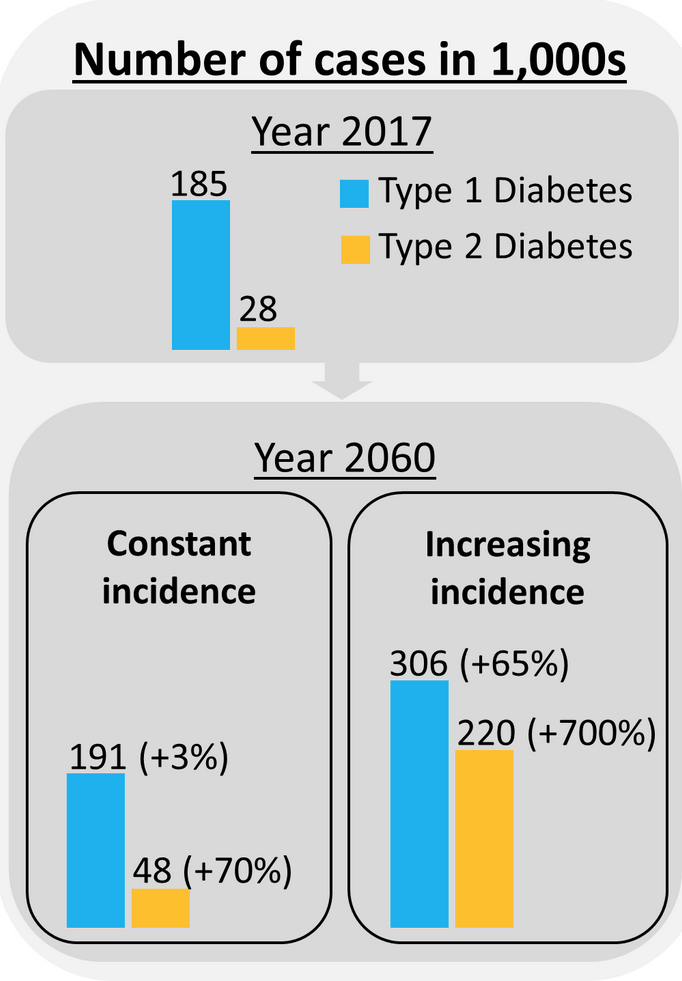
If current trends continue, the total number of American teenagers living with diabetes will rise by at least 12% by the year 2060, a surge driven largely by a staggering 70% increase in Type 2 disease.
That’s the troubling message from Thaddäus Tönnies and colleagues at the Leibniz Center for Diabetes Research at the Heinrich Heine University, Düsseldorf.
The international research team analyzed data from the ongoing SEARCH for Diabetes in Youth study—the largest and most diverse observational study of diabetes trends in Americans under the age of 20.
The SEARCH project, begun in 2000, has compiled comprehensive data from 20,000 participants across the US. Using the SEARCH database, Dr. Tönnies and his group developed mathematical models to predict the future prevalence of diabetes based on the trends observed between 2000 and 2017.
In 2017, there were approximately 213,000 teenagers with diabetes, a marked increase since 2000. During that 17-year period, prevalence of Type 1 increased by roughly 45% and Type 2 grew by 95% (Lawrence JM, et al. JAMA. 2021).
Type 2 Surges
Tönnies and colleagues predict that if the rate of acceleration remains constant, there will be 239,000 people under age 20 diagnosed with some form of diabetes in 2060, a 12% overall increase in prevalence (Tönnies T, et al. Diabetes Care. 2022).

Type 1 remains the most common form of diabetes among children and adolescents. In 2017, approximately 185,000 adolescents had Type 1. Tönnies’ team project that the number of Type 1 cases will reach 191,000 by 2060, a modest 3.2% increase.
The explosive growth will be on the Type 2 side. In 2017, approximately 28,000 teens had Type 2. That will likely hit 48,000 by 2060, a 69% increase.
“Assuming that increasing trends in incidence observed between 2002 and 2017 continue, the projected number of youths with diabetes will be 526,000.” The authors predict.
And that’s the best-case scenario, based on a relatively constant rate of increase. If actual incidence rates increase significantly over the 37 years between now and 2060, the situation could actually be much worse.
Racial & Gender Disparities
Not surprisingly, based on past trends, there are significant gender and racial disparities in the projected increases. Generally speaking, Type 1 diabetes is more common among male versus female adolescents, while Type 2 is more common among females. That overall pattern is expected to remain constant.
For males and females, Type 2 tends to be more common among non-Hispanic Black teens, while Type 1 has a higher prevalence among non-Hispanic White kids.
Assuming current incidence patterns remain stable, the prevalence of Type 2 disease is projected to be around 0.1 cases per thousand for non-Hispanic White teens, 0.6 per thousand for Hispanic/Latino kids, and 1.4 per thousand among non-Hispanic Blacks.
For Type 1 diabetes, Tönnies and colleagues estimate that the prevalence will be 2.9 per thousand for non-Hispanic Whites, 1.6 per thousand for Hispanic/Latinos, and 2.2 per thousand for non-Hispanic Blacks.
“The number of youths with diabetes in the US is likely to substantially increase in future decades, which emphasizes the need for prevention to attenuate this trend,” the researchers concluded.
Given that Type 2 diabetes has the highest growth rate, and this disease is largely a result of bad diet and lack of exercise, the Tönnies study underscores the enormous potential for lifestyle interventions in preventing future cases.
But with prices rising for healthy foods, the ubiquity of sugar-laden snacks and soft drinks, and the dismal economic landscape many families now face, it will be very challenging to make the changes needed to avert the tragic increases that Tönnies predicts.
END







